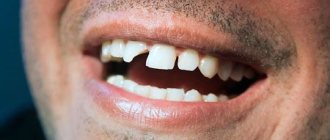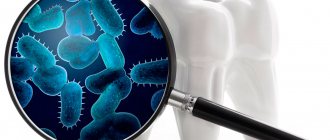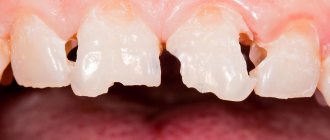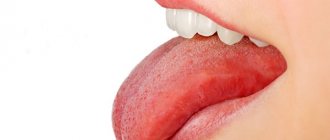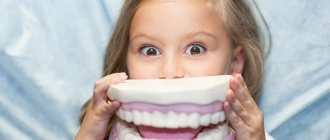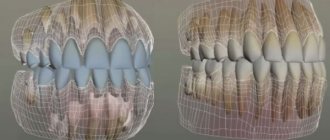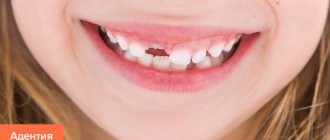Why do teeth rot in adults?
The development of caries and other dental diseases occurs under different circumstances, including:
- Insufficient oral hygiene or its complete absence.
- Poor nutrition, accompanied by the development of excess or deficiency of microelements and vitamins in the body.
- Failure to follow the rules of eating: chewing very cold or very hot food, combining hot and cold, biting into very hard foods.
- Disturbance of metabolic processes in the body.
- Endocrine diseases and temporary hormonal imbalances, due to which the protective properties of saliva are weakened.
- Pathological processes that occur during pregnancy and are associated with the outflow of nutrients from the mother’s body to the developing tissues of the fetus.
- Weak immune activity.
- Hereditary predisposition and improper formation of the dentofacial apparatus.
- The effects of nicotine and alcohol.
- The effect of toxic substances in unfavorable environmental conditions or harmful working conditions.
- Infectious processes due to injuries.
- The presence of untreated infectious processes in any part of the body.
When visiting a dentist, you rarely hear exactly why a particular dental disease has developed. Most often, unfavorable factors act on dental tissues in a complex manner and over a long period of time.
Why do children's teeth rot?
Teeth rot not only in adults, but also in children. In addition to the reasons described, children’s teeth are affected by additional factors that often arise due to the fault of parents:
- Improper nutrition of the mother during pregnancy, due to which the formation of bone and dental tissue of the fetus is abnormal.
- The effect of toxins and medications that enter the mother’s body through smoking, drinking alcohol or self-medicating.
- Long-term use of pacifiers and bottle nipples.
- Night feeding - at night, food particles linger in the mouth for a long time and rot due to the activity of bacteria.
- Late and incorrect teaching of children to maintain hygiene.
- Eating large amounts of sweets, the remains of which create favorable conditions in the mouth for the proliferation of microbes.
Causes of tooth decay
Yes, we all know that you need to brush your teeth 2 times a day, be sure to use dental floss and visit the dentist 2 times a year. Many patients follow these recommendations, but their teeth still deteriorate and rot. Poor hygiene is not the only reason why teeth deteriorate. There are other factors:
- Gum diseases
provoke the proliferation of bacteria, which literally gnaw through the enamel and destroy tooth tissue; - genetics
plays a role in the ability of teeth to resist pathogenic factors; - an unfavorable ecological environment
leads to the fact that in industrial areas there are more dental problems than in places where there are no factories; - Water quality
directly affects teeth. Low content of useful minerals (fluorine, calcium), high content of heavy metal salts can destroy teeth, despite hygiene; - bad habits
. Smokers have worse teeth than non-smokers and treatment is more difficult; - general diseases
, for example, problems with the gastrointestinal tract, negatively affect the condition of the teeth; - carbohydrates
in the diet , as well as hard food products that injure the gums and enamel lead to tooth decay.
To understand why teeth rot, you need to undergo an examination. Don’t be surprised if the doctor asks you to take tests or do an ultrasound. Dental treatment requires a comprehensive approach and diagnosis is more important than ever. Having found out why teeth are rotting, the doctor will prescribe adequate treatment.
Stages of destruction
Tooth decay does not happen overnight. The decay process can take several months, and sometimes six months. It is rare that the cause of the disease is autoimmune diseases or any pathologies.
More often than not, bad teeth are the result of the patient’s dishonest attitude towards his own oral cavity. At any stage of caries development, treatment can be started and the decay process can be prevented from spreading to other teeth. Caries is usually classified according to the following stages:
The appearance of a chalk spot
It is difficult to visually determine the onset of caries; the stain does not cause pain. If you start treatment at this stage, then during preparation you can see how seriously the tooth is damaged from the inside. Sometimes the stain can be cured with a simple fluoride application.
The occurrence of caries
Caries is classified into superficial, medium, deep. The first signs of tooth decay include a reaction to cold and acidic foods. Deep damage by caries manifests itself in the form of constant aching pain, which is often widespread and disappears only after pressing or rinsing with special means.
Pulpitis
Occurs as a result of pulp damage. It is a dental cavity filled with nerve endings, blood vessels and capillaries. Pain due to pulpitis appears at night, when drinking hot or cold drinks. Tooth treatment for pulpitis involves removing the nerves from the canals and thoroughly filling them.
Periodontitis
At the last stage, the pain becomes constant, the tooth begins to loosen, and the inflammatory process spreads to the ligaments. Possible increase in body temperature, extensive sepsis, and the addition of symptoms of general intoxication.
When preparing a dental cavity in the final stages of carious lesions, less than half of the natural tooth remains. The sooner treatment for caries begins, the longer your teeth will remain healthy.
Learn more about dental numbering schemes. In this section you will find photos of gingival fibromatosis.
At this address you will find complete information about effective antibiotics in the treatment of toothache.
Stages
Caries, like a secret agent, begins to act on the sly and may not make itself felt for years. Its initial stage is called the “white spot stage.” Well, how can you see white on white? That is why it is important to visit the dentist regularly - the specialist will highlight the white spot against the background of the enamel and cure caries in time. And if you start it, the disease goes to the next level:
- Surface.
The enamel is still intact, but in the area of the stain it becomes rough. The stain deepens. The tooth begins to react to cold and hot. - Average.
Caries penetrates to the dentin, but it does not provide access to the pulp. A damaged tooth reacts to temperature, mechanical, and chemical stimuli. But the pain is not constant, it goes away quickly. - Deep.
The pain is sharp when touched, but gradually subsides. A carious cavity is visible to the naked eye.
So, after contacting the doctor, the following algorithm will follow:
- X-rays must be taken to determine the condition of the tooth root.
- The doctor examines the coronal part of the unit and assesses the situation.
- Construction of a treatment plan. The patient should be explained in detail about the clinical picture and methods of its treatment.
- Be sure to carry out comprehensive hygienic treatment of the oral cavity in order to thoroughly remove plaque and tartar.
- If the root is in normal condition and has no deviations, the canals are cleaned, the tooth is polished and filled. In some cases, depulpation, that is, removal of the nerve, may be required. This procedure is necessary if pulpitis is observed against the background of advanced caries.
- If the rotting process is observed at the root, then the only option is to remove the damaged unit and further prosthetics.
Why do children's teeth rot?
In children, the composition of saliva is not the same as in adults. Its antibacterial properties are low; in a warm, humid environment, microbes multiply quickly. The disease is not only common, it progresses rapidly. Caries spreads in width and depth. Single events are rare; usually several teeth are affected at once. For children, timely identification and treatment of problem teeth is of particular importance. Rotten teeth can cause:
- pulpitis and periodontitis;
- malocclusion;
- loss of milk and permanent teeth;
- inflammation of the maxillofacial apparatus.
Bad teeth affect the social adaptation of children and lead to psychological problems.
Prevention includes hygiene procedures, limiting sweets, a balanced diet and regular dental examinations.
Consequences for the body
In addition to exclusively external troubles (repulsive appearance, unpleasant smell), which affect a person’s psychological state, it should be taken into account that tooth decay can negatively affect the body as a whole.
Doctors even trace the relationship of this disease with the unsatisfactory condition of the entire skeletal system. This can subsequently cause arthrosis and polyarthritis .
Pathogenic microbes, which invariably accompany decay, are spread by blood and saliva throughout the body. As a result, internal organs are affected or begin to malfunction, which at first glance are completely unrelated to the infection in the mouth. There is also a possibility that decay will spread to the bone that forms the jaw, and then the brain may also be affected.
Teeth and pregnancy
We found out why children's teeth rot. There is another group of people particularly at risk of tooth decay. These are pregnant women. Some scientists classify pregnancy as an immunodeficiency state - the body's resistance to pathogens decreases to such an extent. It’s no wonder that during pregnancy, general diseases worsen and dental problems begin. The increased content of hormones in the body reduces the barrier ability of the epithelium, microorganisms more easily penetrate the gums and begin to multiply.
Help protect your teeth:
- rational and balanced diet;
- multivitamin complexes;
- professional oral hygiene;
- herbal baths;
- applications with calcium and phosphates.
What are the dangers for pregnant women?
During pregnancy, a woman's body experiences maximum stress. Decayed teeth, which are direct sources of infection, worsen the hard work of all systems not only of the mother, but also of the child.
Constant pain causes emotional stress and the release of certain hormones that affect the development of the psyche in children. Rotten crowns can lead to abnormal organ development, micronutrient deficiencies and poor fetal weight gain .
The main danger is that the products of decay of dental tissue stimulate the production of cytokines - substances that provoke contractions of the muscle tissue of the uterus and dilation of the cervical canal. This can cause destruction of the amniotic sac and premature birth.
That is why doctors insist on timely dental treatment. It is possible to eliminate pathologies that appear during pregnancy only during the second trimester.
But if an active or large-scale rotting process is detected, treatment can be carried out at an earlier date. Nowadays, for pain relief, pregnant women use such doses of effective drugs that cannot harm the fetus in any way.
What to do if a tooth is rotten
Until recently, the only solution to the problem was deletion. Today, dental science offers various methods and techniques for restoring teeth.
The method of influence depends on the specific case. What matters is the depth of the lesion, its area, the stage of the disease and the degree of destruction.
Treatment at the initial stage
At the stain stage, you can do without a drill, because it is this that frightens you the most and makes you put off visiting a doctor.
Apply:
- Ozone therapy
. Ozone treatment destroys bacteria, and special preparations restore enamel. - The laser
also destroys bacteria, without heating the tissue and serves as a good preventive measure for gum disease. - Infiltration treatment
.
The chemical composition destroys bacteria, and the infiltration material “seals” the enamel pores and prevents pathogens from penetrating inside.
Treatment for moderate and severe stages
If the disease is advanced, the dentist will still try to save the tooth. At the same time, you can no longer do without a drill. After the examination, the doctor decides how to treat the decayed tooth. But the general principles are the same: after the administration of anesthesia, all dead tissue is removed, the cavity is disinfected and a filling is placed.
If the crown of a tooth has rotted, but the root has been preserved, after treatment the tooth is prepared for prosthetics using:
- Inlays under the stump.
They replace damaged tooth tissue. Inlays are made from zirconium, ceramics, and precious metals. One part of the tab is inserted into the dental canal, and a crown is put on the other. - Pins.
A pin is a rod that is inserted into the dental canal, and a crown is installed on top. They are made of metal or fiberglass.
Modern prosthetics offer a huge variety of materials. Crowns are made from traditional materials: metals and metal-ceramics, composites, zirconium alloys, and modern metal-free compounds.
Severe root damage
Modern dental methods make it possible to save a tooth even with extensive damage.
Depending on the specific situation, the doctor may prescribe:
- Resection - removal of the root apex.
- Hemisection - excision of the damaged part along with the crown that is adjacent to it.
- Amputation is the extraction of the affected part of multi-rooted teeth: one of them is removed.
- Separation is the separation of closely spaced teeth if the carious lesion is localized in the area of branching of the root system.
In rare cases, the doctor strengthens and restores the root not with a filling, but by installing a ceramic or metal stump that protects the tooth from fracture and infection. Of course, such treatment methods are expensive and not available to everyone. Most patients have to have their tooth removed.
Implantation is a solution for advanced cases
Alas, if the root of a tooth has rotted, then the only solution is removal. But even here, dentists offer a method that will help restore a rotten tooth - implantation. The implant will stop bone loss, prevent loosening and tilting of neighboring teeth, and restore your smile. The immediate loading method involves placing an implant immediately after tooth extraction. There is no need to wait for the hole to heal and you can chew almost immediately.

